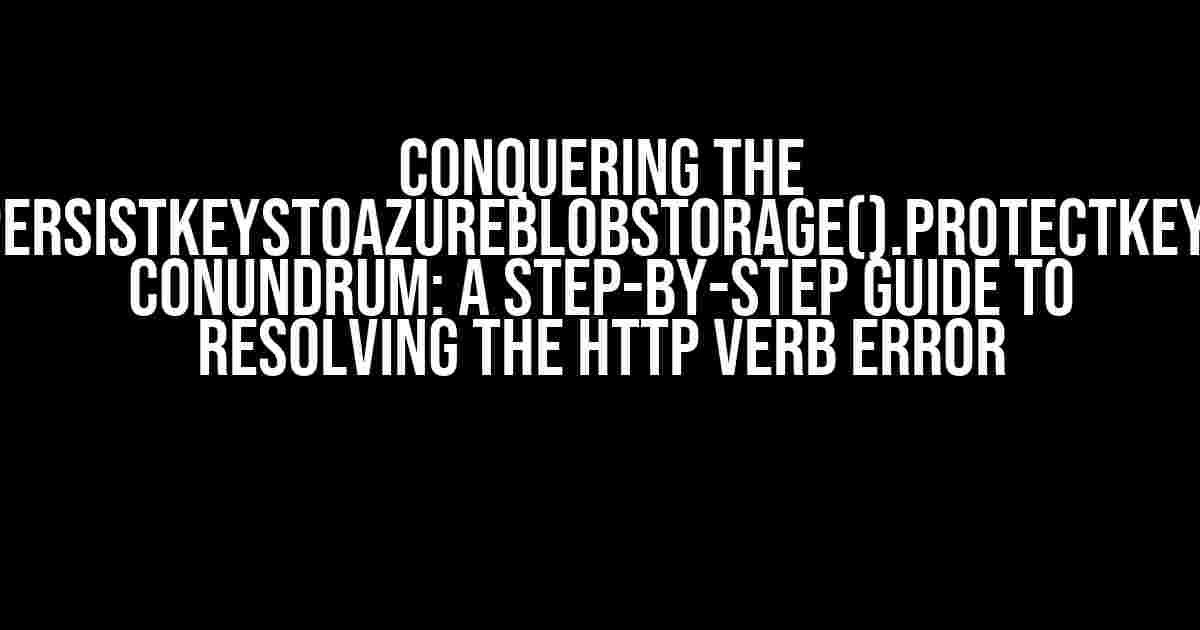Are you tired of encountering the frustrating HTTP Verb error while attempting to access Azure Blob Storage using the AddDataProtection().PersistKeysToAzureBlobStorage().ProtectKeysWithAzureKeyVault() method? Worry no more, dear developer! This comprehensive guide will walk you through the troubleshooting process, providing you with a clear understanding of the issue and a series of actionable steps to resolve it.
Understanding the Error: What’s Going On?
The HTTP Verb error typically occurs when Azure Blob Storage rejects the request made by the AddDataProtection().PersistKeysToAzureBlobStorage().ProtectKeysWithAzureKeyVault() method. This happens when the method attempts to perform an action that Azure Blob Storage doesn’t recognize or doesn’t have permission to execute. In this case, the error is often related to the HTTP verb (GET, PUT, POST, or DELETE) used in the request.
Common Scenarios That Lead to the HTTP Verb Error
- Incorrect Azure Blob Storage configuration
- Invalid or missing Azure Blob Storage credentials
- Inadequate permissions or access control
- Credentials or configuration issues with Azure Key Vault
Step 1: Verify Azure Blob Storage Configuration
Ensure that your Azure Blob Storage configuration is correct and properly set up. Follow these steps:
- Create a new Azure Blob Storage account or use an existing one.
- Generate a new storage account key or use an existing one.
- In your Azure Blob Storage account, create a new container or use an existing one.
- Make a note of the container name, storage account name, and storage account key.
Step 2: Configure the AddDataProtection().PersistKeysToAzureBlobStorage().ProtectKeysWithAzureKeyVault() Method
Now, let’s configure the method to use the correct Azure Blob Storage credentials and settings:
public void ConfigureServices(IServiceCollection services)
{
services.AddDataProtection()
.PersistKeysToAzureBlobStorage(new AzureBlobStorageOptions
{
AccountName = "<YourStorageAccountName>",
ContainerName = "<YourContainerName>",
Credential = new DefaultAzureCredential(new DefaultAzureCredentialOptions
{
TenantId = "<YourTenantId>",
ClientId = "<YourClientId>",
ClientSecret = "<YourClientSecret>",
}),
})
.ProtectKeysWithAzureKeyVault(new AzureKeyVaultOptions
{
Vault = "<YourKeyVaultName>",
Credential = new DefaultAzureCredential(new DefaultAzureCredentialOptions
{
TenantId = "<YourTenantId>",
ClientId = "<YourClientId>",
ClientSecret = "<YourClientSecret>",
}),
});
}
Step 3: Check Azure Key Vault Configuration
Verify that your Azure Key Vault is correctly configured and accessible:
- Create a new Azure Key Vault or use an existing one.
- Generate a new key or use an existing one.
- Make a note of the key vault name, key name, and key version.
- Ensure that the Azure Key Vault credentials are correct and the key is accessible.
Step 4: Troubleshoot HTTP Verb Error
If you’re still encountering the HTTP Verb error, it’s time to dig deeper:
Check Azure Blob Storage Permissions
Ensure that the Azure Blob Storage credentials have the necessary permissions:
| Permission | Description |
|---|---|
| Microsoft.Storage/storageAccounts/blobServices/containers/read | Read access to the blob container |
| Microsoft.Storage/storageAccounts/blobServices/containers/write | Write access to the blob container |
| Microsoft.Storage/storageAccounts/blobServices/containers/delete | Delete access to the blob container |
Verify Azure Key Vault Permissions
Verify that the Azure Key Vault credentials have the necessary permissions:
| Permission | Description |
|---|---|
| Microsoft.KeyVault/vaults/keys/read | Read access to the key |
| Microsoft.KeyVault/vaults/keys/write | Write access to the key |
| Microsoft.KeyVault/vaults/keys/delete | Delete access to the key |
Conclusion
By following these steps, you should be able to resolve the HTTP Verb error when using the AddDataProtection().PersistKeysToAzureBlobStorage().ProtectKeysWithAzureKeyVault() method. Remember to double-check your Azure Blob Storage and Azure Key Vault configurations, as well as the permissions and access control settings. If you’re still encountering issues, don’t hesitate to reach out to the Azure support team or seek guidance from a fellow developer.
Stay tuned for more guides and tutorials on Azure-related topics! If you have any questions or need further clarification, please don’t hesitate to ask.
Frequently Asked Question
Get the answers to the most common issues with AddDataProtection().PersistKeysToAzureBlobStorage().ProtectKeysWithAzureKeyVault() and HTTP Verb Errors!
What is the common cause of HTTP Verb Errors when using AddDataProtection().PersistKeysToAzureBlobStorage().ProtectKeysWithAzureKeyVault()?
One of the most common causes of HTTP Verb Errors is incorrect Azure Storage Blob configuration or permissions. Ensure that the Azure Storage Blob container has the correct permissions and access control settings, and that the application has the necessary credentials to access the blob storage.
How do I troubleshoot HTTP Verb Errors when using AddDataProtection().PersistKeysToAzureBlobStorage().ProtectKeysWithAzureKeyVault()?
To troubleshoot HTTP Verb Errors, check the Azure Storage Blob logs for any errors or exceptions. You can also enable debug logging in your application to get more detailed error messages. Additionally, verify that the Azure Storage Blob container exists and that the application has the necessary permissions to access it.
What are the required permissions for AddDataProtection().PersistKeysToAzureBlobStorage().ProtectKeysWithAzureKeyVault() to work correctly?
The required permissions for AddDataProtection().PersistKeysToAzureBlobStorage().ProtectKeysWithAzureKeyVault() include the Microsoft.Azure.KeyVault and Microsoft.Azure.Storage Blob permissions. Additionally, the application needs to have the necessary credentials to access the Azure Key Vault and Azure Storage Blob.
How can I resolve the “The request method ‘GET’ is not supported for this resource” error when using AddDataProtection().PersistKeysToAzureBlobStorage().ProtectKeysWithAzureKeyVault()?
This error typically occurs when the Azure Storage Blob container is not configured correctly. Ensure that the container is created and exists, and that the application has the necessary permissions to access it. Also, verify that the Azure Storage Blob client is configured correctly, and that the correct HTTP verb is being used for the operation.
What are the best practices for using AddDataProtection().PersistKeysToAzureBlobStorage().ProtectKeysWithAzureKeyVault() in a production environment?
Best practices for using AddDataProtection().PersistKeysToAzureBlobStorage().ProtectKeysWithAzureKeyVault() in a production environment include using secure credentials and access control, configuring Azure Storage Blob and Azure Key Vault correctly, and regularly monitoring and logging errors and exceptions.
